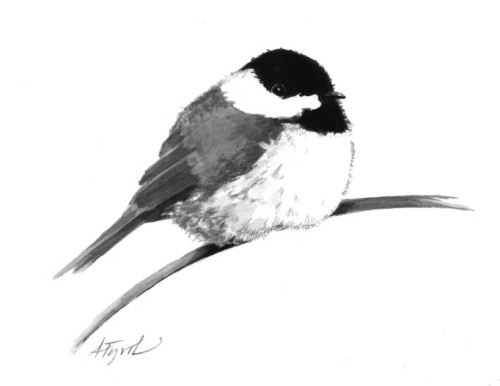
We humans are pretty lucky when it comes to winter. When the temperature plunges to 20 below, we can venture bravely forth clad in our stylish new slim-puffy jackets and Ugg boots. But what about all the other critters out there? The ones whose only protection from the meat locker of winter northern woods is the hair on their hides? Well, they have. . . the hair on their hides. But that hair has evolved some neat adaptations to fend off frigid temperatures.
Most of the animals that haven’t flown south or holed up in a cozy den are endowed with fat, feathers, and fur that bulk up as winter approaches. Fat both insulates and serves as a food reserve when foraging is lean. By remaining extremely inactive, some animals, like raccoons, maintain such slow metabolisms that they can live exclusively off stored fat all winter. Feathers and fur, though, are an animal’s first line of defense.
Birds that stick around New Hampshire and Vermont, like blue jays, chickadees, and goldfinches, set about growing more insulating down feathers as winter approaches. Chickadees will grow a coat that’s 25 percent thicker than their summer wear. On cold days, birds fluff these feathers out to trap body heat. They look about as bulky as we do with five layers on, though cuter.
Most mammals sport a soft undercoat as well as a thicker, coarser overcoat. The undercoat serves to insulate, and it grows thicker in winter. This process is triggered by shortening days rather than dropping temperatures. Growth of the winter coat is preceded by shedding of the summer coat, a process that works in reverse in spring. (Humans shed seasonally too – one more reason to launder those sheets at least twice a year.) The overcoat is made up of guard hairs, which repel snow, absorb heat from the sun, and trap heat that escapes through the undercoat.
Deer and moose have especially effective overcoats – they are the only mammals with hollow guard hairs, which have exceptional insulating qualities. According to biologist Susan Morse, it is not uncommon to come across a deer with a dusting of snow on its back that is not melted by the body’s warmth. The synergy between the deer’s undercoat (completely shed in the spring) and guard hairs makes such an effective insulation that the snow on its back stays frozen.
Moose guard hairs, says Morse, collect and transmit the sun’s energy into the dense undercoat, where the dark-colored skin further absorbs the warmth, resulting in an elevation of skin surface temperature. “This layer of warmth,” she says, “is then retained by the woolly undercoat, which in effect creates a warm-air insulating layer that minimizes loss of heat from the body core.” She adds that biologists have observed captive moose in Alaska that don’t shiver even as temperatures reach 50 degrees below zero!
Otters, while lacking hollow guard hairs, have a coat that seems tailor-made for their semi-aquatic lifestyle, even in winter. Biologists have calculated that in just one square inch of otter coat, there are around 400,000 hairs. What makes all the difference, says Morse, is the impenetrability of the otter’s woolly undercoat in tandem with its outer guard hairs, which are both united with each other via interlocking scales and crimped in order to retain more warm air. As otters dive into the water, all this warm air is squeezed out of the coat, which Morse says is easily observed in the mass of air bubbles radiating up from the swimming animal.
In order to re-loft their coats, otters must constantly groom and dry themselves – the reason for haul-outs, packed areas of snow on the shores of ponds where otters dwell. According to Morse, these areas are almost always south- or southwest-facing, protected spots that allow for optimal conditions for otters to absorb and retain the sun’s warmth in preparation for the next dive.
Braving frigid air and water, otters just might be at the opposite end of the cold-tolerance scale from people. Having long ago lost our thick coats of winter fur (though not, perhaps, winter fat), we’re fortunate to be able to compensate with artificial undercoats and overcoats – longjohns and parkas – of synthetic materials, and also the tried-and-true coats of our wild cousins, the down and wool and even fur that keeps us toasty warm through the long nights of a northern winter.


Discussion *